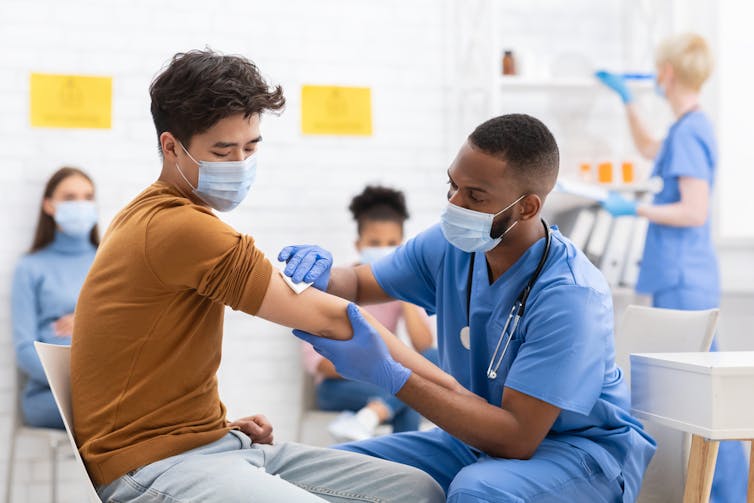Source: The Conversation (Au and NZ) – By Holly Seale, Associate professor, UNSW
Australia launched its COVID-19 vaccination campaign last week, beginning with frontline workers in hotel quarantine, health care and aged care.
But one critical question is whether the immunisation program will meet the needs of people from culturally and linguistically diverse (CALD) backgrounds.
People from CALD backgrounds form a significant and growing share of Australia’s frontline workforce. This is especially true for aged, disability and community care, as well as hotel quarantine.
For example, 37% of Australian frontline care workers were born overseas according to 2016 statistics. Around 28% are from non‐English‐speaking backgrounds.
Others may have low health literacy skills or find it challenging to track down and understand information about COVID vaccines. Lower health literacy is associated with a reluctance to accept vaccines. Recent studies also suggest those who speak a language other than English at home are less willing to get vaccinated than those who speak English only.It’s critical we deliver a program aligned with the needs of CALD communities to ensure high levels of public confidence in the COVID vaccine rollout.
To achieve this, in February the federal government released a plan to ensure COVID vaccine rollout information and services are accessible for CALD communities.
The plan outlines the need for clear messaging that’s inclusive, tailored and translated. It also emphasises the importance of working with community leaders and multicultural community organisations.
Our new research, published today, supports the actions outlined in the plan but also highlights areas needing more focus.
We interviewed people working in multicultural and refugee agencies, as well as stakeholders in CALD community organisations, to understand barriers around communication and engagement during the pandemic.
Information gaps
Our research found gaps in information available during the pandemic. For example, there have been delays in making translations available.
Many people have sought information and news from their countries of origin to fill these gaps. This information may be irrelevant to the Australian situation, or contradictory to local recommendations.
There’s a divide between governments and individuals, with some people feeling like they’ve been left behind. Issues such as an inability to navigate government websites or difficulties accessing support have contributed to this divide.
Translated COVID information hasn’t always been appropriate for people with low literacy or low health literacy levels. This stems from the original source materials in English not being suitable, or translations not being reviewed to make sure the information makes sense.
Newly arrived migrant communities are most in need, as many don’t have established networks to support them. Translated resources have mostly been developed for larger, established CALD groups rather than new and emerging communities. There’s been a lack of tailoring in how messages and information are communicated, and ethnic newspapers and media haven’t been effectively used.
Some people are worried they’ll lose their jobs if they refuse to get vaccinated. The challenge is they don’t have anyone to ask questions of, and are unable to access trustworthy material online.
One issue that was repeatedly raised was burnout experienced by community leaders and other stakeholders. These leaders are asked to repeatedly translate, turn “government speak into community speak”, spread messages and answer questions. They take on this role in addition to their normal responsibilities, with little to no financial support and often with an emotional burden.
The federal government’s plan recognises we need to work with community leaders, but little detail has been provided about whether support, training or resources will be available.

Here’s how things could change
Beyond the need to support community leaders, we also heard from participants about ways to improve communication and vaccine delivery.
Our research team makes a number of recommendations, including the need to:
-
identify other community ambassadors and provide training to build their knowledge and confidence
-
employ bilingual engagement officers from local communities, to support action being taken by communities themselves. Similar engagement officers have been used to support participation in Australian Bureau of Statistics data collection. Census engagement officers work within communities telling people about the census and ensuring everyone can take part and get the help they need. Internationally, this strategy has been used to promote HIV testing and counselling by encouraging community members to talk about the issues
-
invite local CALD communities to initiate and host forums in media of their choice, and to ensure government officials are available to answer questions
-
develop a glossary of immunisation terms. This would enable standard terminology relevant to COVID for community organisations, community and faith-based leaders, translators and interpreters
-
set up vaccination clinics in locations where communities feel safe. This could include outdoor facilities, sports clubs, community centres, faith-based locations and schools. Ensure there are transport options available
-
undertake ongoing surveys to capture how CALD communities feel, think and act in relation to the Australian COVID vaccination program. Tailoring messages will only be effective when informed by the issues that communities are actually concerned about
-
and support alliances between immunisation experts and those working in refugee health and multicultural services.
Participants repeatedly used the phrase “community ownership” during the interviews. It’s critical to genuinely engage communities in the development and testing of communication messages, images and videos. It’s also critical we work with different communities to identify the best ways to pass on information.
And when it comes down to it, word of mouth messages and conversations may be the most effective way to get people involved with the COVID vaccine program.
By supporting the development of community ambassadors to address misinformation and concerns about vaccine safety at a local level, the government will have the best chance of ensuring information reaches those who need it.
– ref. How can governments communicate with multicultural Australians about COVID vaccines? It’s not as simple as having a poster in their language – https://theconversation.com/how-can-governments-communicate-with-multicultural-australians-about-covid-vaccines-its-not-as-simple-as-having-a-poster-in-their-language-156097







